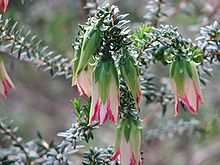- Darwinia meeboldii
-
Darwinia meeboldii 
Scientific classification Kingdom: Plantae (unranked): Angiosperms (unranked): Eudicots (unranked): Rosids Order: Myrtales Family: Myrtaceae Genus: Darwinia Species: D. meeboldii Binomial name Darwinia meeboldii
C.A.Gardner[1]Darwinia meeboldii (Cranbrook Bell) is a shrub which is endemic to the south-west of Western Australia.[2] It has an erect and straggly habit, growing to between 0.5 and 3 metres high.[2] The bracts around the flowers form a pendent "bell" which is usually white with red tips.[3] A group of 8 small flowers are concealed inside. These are primarily produced between August and November.[2][3]
It occurs on peaty soils on slopes in the western part of the Stirling Range National Park.[2][4]
Cultivation
The species requires good drainage and protection from direct sun.[3] It is difficult to propagate from seed, but cuttings strike readily.[3] Grafting on stocks of Darwinia citriodora may be carried out in areas with unsuitable growing conditions including high humidity.[3]
References
- ^ "Darwinia meeboldii". Australian Plant Name Index (APNI), IBIS database. Centre for Plant Biodiversity Research, Australian Government, Canberra. http://www.anbg.gov.au/cgi-bin/apni?TAXON_NAME=Darwinia+meeboldii. Retrieved 2009-07-23.
- ^ a b c d "Darwinia meeboldii". FloraBase. Department of Environment and Conservation, Government of Western Australia. http://florabase.dec.wa.gov.au/browse/profile/5517.
- ^ a b c d e "Darwinia meeboldii". Australian Native Plants Society (Australia). http://asgap.org.au/d-mee.html. Retrieved 2009-07-24.
- ^ "Approved Conservation Advice for Darwinia meeboldii (Cranbrook Bell)". Department of the Environment, Water, Heritage and the Arts. 2008. http://www.environment.gov.au/biodiversity/threatened/species/pubs/21512-conservation-advice.pdf. Retrieved 2009-07-24.
Categories:- Darwinia
- Rosids of Western Australia
- Myrtaceae stubs
- Western Australian plant stubs
- Australian rosid stubs
Wikimedia Foundation. 2010.
